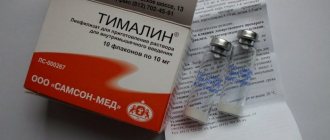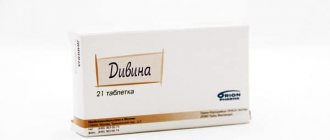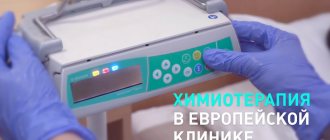Pharmacological properties of the drug Methylprednisolone
Synthetic corticosteroids are similar in pharmacological properties to hydrocortisone, but are superior in activity. It has a pronounced anti-inflammatory, antiallergic and immunosuppressive effect. Does not have mineralocorticoid activity. Affects carbohydrate, protein, lipid metabolism. Reduces the number of immunocompetent cells at the site of inflammation, reduces vasodilation, stabilizes lysosomal membranes, and reduces the production of prostaglandins and leukotrienes. Has a catabolic effect. Reduces the absorption of glucose by peripheral tissues, which can lead to hyperglycemia and glucosuria, especially in patients predisposed to diabetes. After oral administration, it is well absorbed in the small intestine. Plasma protein binding is 40–90%. The half-life is 2–4 hours. Metabolized in the liver. It is excreted in the urine, mainly in the form of metabolites (glucuronides, sulfates and unconjugated compounds). The half-life is about 3 hours. The drug penetrates the placental barrier and also into breast milk. After intramuscular administration in the form of a depot suspension at a dose of 40 mg, the maximum concentration in the blood plasma is achieved on average after 7.3 hours and averages 1.48 mcg/100 ml. The half-life is 69.3 hours. The duration of suppression of the hypothalamic-pituitary-adrenal system is 4-8 days. After intra-articular injection of 40 mg depot suspension into each knee joint (total dose 80 mg), the maximum plasma concentration is reached after 4-8 hours and is approximately 21.5 mcg/100 ml. The entry of the active substance into the systemic circulation from the joint cavity persists for approximately 7 days.
Pharmacodynamics and pharmacokinetics
approximately 5 times more pharmacologically active than the hormone cortisone The substance suppresses the work of tissue macrophages and leukocytes , inhibits the release of interleukin-1 , interleukin-2 , interferon gamma from macrophages and lymphocytes .
The drug also has the ability to suppress the release of ACTH by the pituitary gland, the secretion of FSH and TSH, without reducing the level of circulating beta-endorphin .
After entering the human body, the substance interacts with specific receptors located in the cytoplasm, forming a complex that stimulates the synthesis of messenger RNA in the cell nucleus and the formation of proteins, including lipocortin . The lipocortin protein, in turn, inhibits the activity of the phospholipase A2 and suppresses the production of arachidonic acid . As a result, the glucocorticoid inhibits the synthesis of inflammatory mediators prostaglandins, leukotrienes and endoperoxides. The intensive production of COX (mainly COX2 ) and the production of prostaglandins .
The drug stabilizes lysosome membranes and reduces the concentration of proteolytic enzymes at the site of inflammation. Capillary permeability also decreases, usually increasing under the influence of histamine .
Depending on the dose taken, the substance affects the metabolic processes of carbohydrates, proteins and fats. The protein content in the blood plasma decreases and the globulin/albumin albumin synthesis occurs more intensely in the tissues of the kidneys and liver.
a catabolic effect on lymphoid and connective tissue, skin, muscle, adipose and bone tissue , which can lead to growth suppression in children. The drug stimulates the synthesis of TG and fatty acids , which causes hypercholesterolemia . Carbohydrates are absorbed more intensively from the gastrointestinal tract, the activity of the enzyme glucose-6-phosphatase , and glucose enters the blood from liver tissue much more intensely. The drug is a gluconeogenesis . Water and sodium ions , potassium is excreted more intensively and calcium is absorbed (washed out of the bones through the kidneys).
The use of high dosages of the drug leads to a lowering of the threshold of convulsive activity and the development of convulsions and seizures. The antiallergic effect of the drug is associated with the suppression of the synthesis and secretion of allergy mediators, histamine , the number of circulating basophils , lymphoid and connective tissue, circulating lymphocytes, mast cells stop developing, and the sensitivity of effector cells decreases. antibody production is also inhibited , and the immune response of the body as a whole changes.
When treating COPD with Methylprednisolone, inflammatory processes are inhibited, swelling is relieved, and eosinophilic infiltration of the submucosal layer of the epithelium in the bronchi is inhibited. Under the influence of the drug, the sensitivity of beta-adrenergic receptors to sympathomimetics and catecholamines increases, mucus thins, and the intensity of its production decreases.
The drug also has an antitoxic and anti-shock effect on the body. This process occurs due to increased blood pressure, vasoconstriction, decreased vascular permeability, activation of the production of specific liver enzymes and metabolism of xeno- and endobiotics . Due to inhibition of the production of interleukin-1 , interferon gamma and interleukin-2 from lymphocytes and macrophages, the drug has an immunosuppressive effect.
The synthetic hormone stimulates the production of stomach acids and pepsin , which increases the risk of ulcers and stomach erosions.
Indications for use of the drug Methylprednisolone
- endocrine diseases, such as primary or secondary adrenal insufficiency, non-suppurative thyroiditis, hypercalcemia due to tumor disease;
- rheumatoid arthritis, juvenile rheumatoid arthritis (short-term course as an auxiliary therapy for exacerbation of the process);
- inflammatory-degenerative and metabolic diseases of the joints, including psoriatic arthritis, ankylosing spondylitis, acute and subacute bursitis, acute and nonspecific tenosynovitis, acute gouty arthritis, post-traumatic osteoarthritis, synovitis in osteoarthritis, epicondylitis (short-term course as an auxiliary therapy for exacerbation of the process) ;
- rheumatic carditis, polymyalgia rheumatica (mainly during exacerbation);
- systemic connective tissue diseases, such as systemic lupus erythematosus, dermatomyositis, acute giant cell arthritis (during an exacerbation or as maintenance therapy);
- skin diseases such as pemphigus, bullous dermatitis herpetiformis, severe erythema multiforme, exfoliative dermatitis, mycosis fungoides, severe psoriasis, severe seborrheic dermatitis;
- allergic diseases with a severe course that are not amenable to adequate traditional therapy and lead to disability of the patient, for example, seasonal or chronic allergic rhinitis, serum sickness, asthma, drug allergies, contact or atopic dermatitis;
- eye diseases (severe acute and chronic processes), such as allergic marginal corneal ulcer, herpetic eye lesions, inflammation of the anterior segment of the eye, diffuse posterior uveitis and choroiditis, sympathetic ophthalmia, allergic conjunctivitis, keratitis, chorioretinitis, optic neuritis, iritis and iridocyclitis;
- respiratory diseases, such as symptomatic sarcoidosis, Loeffler's syndrome, berylliosis, focal or disseminated pulmonary tuberculosis (with simultaneous anti-tuberculosis chemotherapy);
- hematological diseases such as idiopathic thrombocytopenic purpura in adults, secondary thrombocytopenia in adults, autoimmune hemolytic anemia, erythroblastopenia, congenital hypoplastic anemia;
- leukemia and lymphoma in adults, acute leukemia in children (as part of complex therapy);
- nonspecific ulcerative colitis, regional enteritis;
- multiple sclerosis in the acute phase;
- trichinosis with damage to the nervous system or myocardium;
- prevention of rejection after organ transplantation;
- nephrotic syndrome;
- cerebral edema due to brain tumor;
- tuberculous meningitis with a subarachnoid block or with a threat of block development (with simultaneous anti-tuberculosis therapy).
Interaction
Combination use of the drug with Metformin, Glibenclamide or insulin reduces the effectiveness of this type of drug.
The simultaneous use of the drug and oral anticoagulants ( Heparin ) can lead to both a decrease and an increase in the effectiveness of the drugs.
Taking medication with non-steroidal anti-inflammatory drugs can cause and ulcerative lesions of the gastrointestinal tract.
Barbiturates can reduce the effectiveness of this substance.
When a corticosteroid is combined with thiazide diuretics , including Furosemide hypokalemia increases .
of salicylates may be significantly reduced .
Ketoconazole and Itraconazole cause an increase in the plasma concentration of this drug.
Taking Methylprednisolone with Methotrexate further reduces immunity.
When therapy is carried out with a drug containing pyridostigmine or neostigmine, myasthenic crisis may occur .
Pancuronium reduces neuromuscular blockade.
The drug increases the effectiveness, but at the same time increases the toxicity of Salbutamol .
The medicine should be combined with caution with Rifampicin , this may lead to an increase in the intensity of its clearance.
The pharmacological activity of the drug is reduced by the action of phenytoin and phenobarbital .
The medicine reduces the effect of phenytoin , Cyclosporine , Erythromycin .
Use of the drug Methylprednisolone
Recommended methods of administration: orally, intramuscularly, intra-articularly, periarticularly, intrabursally, into soft tissues, into a pathological focus, instillation into the rectum. The dose is set individually depending on the nature of the disease and its severity. Orally - at an initial dose of 16–96 mg for 24 hours; for long-term treatment, the minimum possible dose should be prescribed; It is advisable to take every other day in the morning. The maintenance dose for adults is 4–12 mg/day. Parenterally: administered intravenously, intravenously and intramuscularly, usually at a dose of 100–500 mg. To eliminate shock conditions and rejection reactions during organ transplantation for a limited time, the dose can be increased to 30 mg/kg. Methylprednisolone in high doses should be administered as an intravenous drip infusion over at least 10 minutes. To eliminate nausea and vomiting caused by taking cytostatics, 250 mg of methylprednisolone is administered 20 minutes before taking cytostatics and 250 mg 6 hours after taking. When treating young and middle-aged children, the dose should be reduced, but it should be at least 25 mg/day. There are the following regimens for the use of methylprednisolone. Continuous circuit. It is administered taking into account the circadian rhythm of endogenous cortisol secretion. For this purpose, 2/3 of the daily dose is prescribed in the morning, 1/3 in the afternoon. Alternating scheme. Prescribe a double dose of methylprednisolone once in the morning every other day. This regimen of use does not reduce the therapeutic effect, but significantly reduces the incidence of side effects, primarily suppression of the hypothalamic-pituitary-adrenal system, compared to continuous use. On break days, it is advisable to prescribe additional NSAIDs. An alternating regimen of use is especially indicated for use in children, since it does not interfere with the normal growth of the child. In case of moderate severity of the pathological process, alternating therapy can be prescribed from the very beginning of the course of treatment. In severe cases, to eliminate acute manifestations of the disease, continuous treatment is required (usually 4–10 days is sufficient for most allergic diseases and collagenoses). Then there are 2 options: 1) switching to alternative therapy with a gradual reduction in the dose of steroids taken every other day; 2) a gradual reduction in the dose of steroids taken on a continuous basis to a maintenance level, after which a transition to an alternating regimen is made. Theoretically, the first option is more promising. Patients taking GCS for a long time on a continuous basis (rheumatoid arthritis) should try to switch to an alternating dose. However, strong suppression of the hypothalamic-pituitary-adrenal axis complicates the task of transferring to an alternating circuit. Perhaps at the first stage there will be a need to take not double, but triple or even quadruple the dose of methylprednisolone every other day. After achieving control over the course of the disease, the dose can be gradually reduced. Intermittent therapy. Similar to alternating, but the use of methylprednisolone is carried out in short courses of 3-4 days, followed by 4-day intervals between courses. Pulse therapy. A fairly rapid infusion of ultra-high doses of methylprednisolone (500–1000 mg) over 30 minutes is used, the course is 3 days. The maximum concentration in the blood plasma after such an infusion is observed during the first hour, after which the drug is quickly redistributed in the body, and after a day its minimum concentration is determined in the serum. Pulse therapy does not cause sudden changes in the biochemical parameters of blood and urine (the concentration of glucose in the blood may increase, which may persist for several days). Changes in the cardiovascular system occur rarely; the most common complication is increased blood pressure; There are reports of the development of arrhythmia (sinus bradycardia), which can persist for 5 days. When conducting pulse therapy, the following rules are adhered to: a strict selection of candidates for pulse therapy is carried out (severe forms of diseases that are not amenable to conventional treatment with corticosteroids, visceral forms of rheumatic diseases); methylprednisolone infusion at a dose of 1000 mg is carried out over 30–40 minutes; monitor the patient’s general condition, heart rate, blood pressure, respiratory rate once before the infusion and at least 3 times during the day after the infusion; immediately respond to any patient complaints that arise during or after the infusion, repeating the clinical examination; They especially monitor the condition of patients with diseases of the cardiovascular system (hypertension, arterial hypertension, heart block) and diabetes mellitus. Advantages of pulse therapy: quick and effective reduction of symptoms; sustainable therapeutic effect (up to 1 year); reduced risk of side effects, positive dynamics during the course of the disease (especially in the early stages of the pathological process). Local application: for rheumatoid arthritis or osteoarthritis, the dose depends on the size of the joint and the severity of the disease; if necessary, injections can be repeated at intervals of 1–5 weeks or more. 20–80 mg of methylprednisolone is injected into a large joint; average - 10–40 mg; small - 4–10 mg. It is important to introduce the solution into the synovial space. For tendonitis and tenosynovitis, it is injected into the tendon sheath; for tendon sheath cysts, it is injected directly into the cyst. The dose is selected individually; it can range from 4 to 30 mg. Injections can be repeated. For skin diseases, 20–60 mg is injected directly into the lesion. For large lesions, it is possible to distribute the dose (20–40 mg) over several local injections. When a high dose is administered, the affected skin may turn white and peel. The course of treatment is 1–4 injections, intervals are individual. Rectal administration of the suspension is indicated for nonspecific ulcerative colitis. Prescribed as microenemas or rectal drips at a dose of 40–120 mg 3 to 7 times a week for 2 weeks or more. In most cases, 40 mg of methylprednisolone in 30–300 ml of water is sufficient. Depot suspension: IM 40–120 mg, if necessary, every 1–4 weeks. Intra-articular, depending on joint size, 4–80 mg as needed every 1–5 weeks. 4–30 mg is injected into the synovial bursae and tendon sheaths, and 20–60 mg into the area of skin lesions (the drug cannot be administered subcutaneously or intradermally). 40–120 mg is administered rectally as an enema 3–7 times a week.
Side effects of the drug Methylprednisolone
Fluid and electrolyte imbalance: sodium and fluid retention, congestive heart failure (in predisposed patients), potassium loss, hypokalemic alkalosis. From the musculoskeletal system: steroid myopathy, muscle weakness, osteoporosis, pathological fractures, aseptic bone necrosis. From the central nervous system : increased intracranial pressure, pseudotumor of the cerebellum, mental disorders, convulsions. From the endocrine system and metabolic processes: menstrual irregularities, Itsenko-Cushing syndrome, suppression of the pituitary-adrenal axis, decreased tolerance to carbohydrates, steroid diabetes, negative nitrogen balance as a result of protein catabolism, growth retardation in children. From the organs of vision : posterior subcapsular cataract, increased intraocular pressure, exophthalmos. From the digestive tract: pancreatitis, esophagitis, erosive and ulcerative lesions of the digestive tract, including bleeding and perforation. Side effects caused by the immunosuppressive effect of methylprednisolone: decreased body resistance to infections, activation of latent infections, opportunistic infections, deterioration of wound healing. Allergic reactions: skin manifestations, anaphylactic shock. Dermatological reactions: petechiae, ecchymosis, thinning and fragility of the skin. Local reactions: hyper- or hypopigmentation, atrophy of the skin and subcutaneous fat, post-injection exacerbation after intrasynovial use, abscesses. Other: when administered into pathological lesions in the head area, blindness developed in rare cases.
Overdose
In case of an overdose of the drug, the following are observed: swelling, protein in the urine, decreased filtration volume, cardiac arrhythmia , low blood pressure, cardiopathy , low potassium content in the blood. With long-term use of large dosages of the drug, Itsenko-Cushing syndrome .
As treatment, forced diuresis is performed and potassium chloride . If the patient has depression or psychosis , it is recommended to reduce the dosage of the drug or discontinue it and use phenothiazine drugs or lithium salts .
Special instructions for the use of the drug Methylprednisolone
It should be used with caution and only under the strict supervision of a physician in severe forms of hypertension (arterial hypertension) and chronic heart failure, acute endocarditis, Itsenko-Cushing's disease, psychosis, nephritis, osteoporosis, peptic ulcers, syphilis, active forms of tuberculosis, diabetes mellitus. Caution is also necessary in case of herpetic infections (danger of corneal perforation), ulcerative colitis, diverticulitis, peptic ulcers, myasthenia gravis, and the presence of a recent intestinal anastomosis. In case of acute infectious disease, do not apply topically. Injecting the drug into previously infected joints should be avoided. After intra-articular administration, the joint should be unloaded. This is especially important during the period of symptomatic improvement. If there is exudate and hygroma, a puncture must be performed before administration. Intradermal injection should not be deep. An IM injection is performed deep into the gluteal muscle. It is necessary to avoid injection into the deltoid muscle, since in this case there is a high risk of developing atrophy of the subcutaneous fatty tissue. During treatment with methylprednisolone, vaccinations and immunizations should not be carried out due to the possibility of neurological complications and the lack of antibody formation. During treatment with methylprednisolone, it is possible to suppress reactions in tests with skin allergens. During pregnancy and lactation, it is used only when the expected therapeutic effect for the woman exceeds the potential risk to the fetus or child. Experimental studies revealed the embryotoxic effect of methylprednisolone.
Contraindications
If the medicine is used once or for a short period of time, it should not be used if you are allergic to Methylprednisolone.
Injection into a joint or directly into the affected area is contraindicated:
- after arthroplasty ;
- with pathological bleeding (endogenous or resulting from treatment with anticoagulants );
- after an intra-articular bone fracture ;
- for joint sepsis or periarticular infection ;
- patients with general infectious diseases due to decreased immunity ;
- with severe periarticular osteoporosis ;
- if there are no signs of inflammation in the joint;
- with severe bone destruction and joint deformation;
- patients with unstable joints due to arthritis ;
- with aseptic necrosis of the epiphyses of bones forming the joint .
The active substance is not prescribed externally:
- for viral, fungal or bacterial diseases;
- patients with skin tuberculosis ;
- for skin manifestations of syphilis ;
- patients with skin tumors;
- in the period after vaccination;
- for ulcers, wounds and other violations of the integrity of the skin;
- children under 2 years old;
- for rosacea or acne vulgaris ;
- patients with perioral dermatitis .
In ophthalmic practice the product is not used:
- for eye tuberculosis ;
- patients with fungal, viral or bacterial eye diseases;
- with trachoma ;
- if the integrity of the ocular epithelium is compromised.





